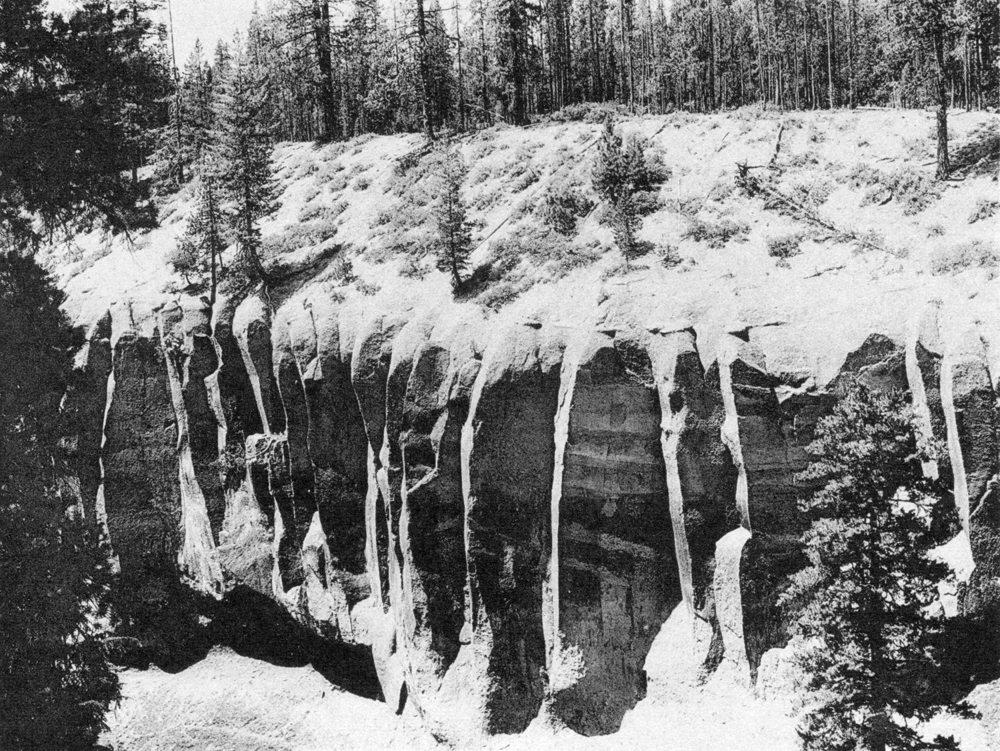In the canyons, the dark scoria commonly shows a well developed columnar structure (plate 17, figure I), caused by slow cooling of the compacted ejecta. So well is this structure developed that the deposits have often been mistaken at a distance for columnar flows of basaltic lava.
|
Plate 17. Fig. 1. Columnar scoria flow overlain by crystal- and lithic-rich ash, Annie Creek canyon. (Photograph by William Schoeb.) |
Most of the basic scoria consists of highly vesicular brown glass, heavily charged with slender prisms of hornblende and fewer crystals of pyroxene and plagioclase. Some bombs, particularly in the Pumice Desert, are almost wholly composed of hornblende prisms.
Compared with the pumice flows immediately below, the scoria flows are generally much more crystalline. A few typical samples will illustrate the point. Considering only the fraction in the size range 0.25 to 10 mm, the pumice flow in Godfrey’s Glen carries only 3 per cent by volume of crystals, whereas the overlying zone, transitional between the pumice and scoria flows, carries 9.6 per cent and the dark scoria, 14 per cent. Farther down Annie Creek, at the main falls, the pumice flow contains 8.7 per cent of discrete crystals and the scoria above carries 14 per cent. There are, however, other pumice flows which are richer than any of the scoria flows in crystals, as the histograms, figures 25 and 26, show.
Another feature distinguishes the pumice flows from the scoria flows, namely, the higher proportion of heavy minerals in the latter. Though the ratio of feldspar to heavy minerals in the pumice deposits ranges between 5:3 and 7:1, averaging approximately 3:1, the ratio in the scoria flows rarely departs much from 1:1. Presumably this increase in heavy minerals among the scoria flows was caused by gravitative settling in the magma chamber prior to eruption. For the same reason, the final ash fall which followed the scoria flows is abnormally rich in crystals.
Significant in connection with the mode of deposition of both the pumice and the scoria flows is their high porosity. Coupled with the high content of fine dust, it signifies continuous frothing of the ejecta during transport. It was this auto-explosive property that enabled the flows to move for such long distances even down slight gradients.
Neither the pumice flows nor the scoria flows contain more than a very few breadcrust bombs. The reason is not far to seek: in order to form breadcrust surfaces, bombs must be suddenly chilled on the outside while the gases within continue to expand and produce tension cracks in the glassy skins. When bombs are blown high in the air the tendency is, of course, for the crust to chill to glass. If, on the other hand, the bombs remain hot until most of their gas is exhausted, as they must do in glowing avalanches, they fail to acquire glassy “breadcrusts.” Accordingly the conclusion seems warranted that when the pumice and scoria flows were erupted, few of the ejecta rose high above the crater. The bulk of the fragments fell to earth almost at once and, enclosed in the hot gases of the avalanches, lost their heat slowly.
***previous*** — ***next***


